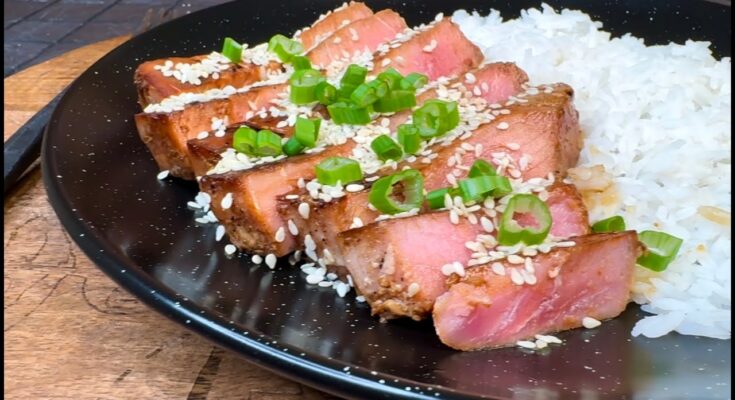Tuna Recipe: Tuna is one of those versatile, nutrient-packed ingredients that fits into almost any meal plan. Whether you’re a fan of quick lunches, light dinners, or gourmet feasts, tuna’s got your back. It’s available in various forms—fresh, frozen, canned—and adapts effortlessly to different cooking styles. What makes it even more appealing is its rich flavor, which can be both mild and meaty depending on how it’s prepared. You can enjoy it raw in sushi, seared as a steak, or mixed into a hearty casserole.
Think of tuna as the denim of the culinary world—casual, reliable, and adaptable to nearly anything. It’s perfect for those days when you want to throw something together without compromising on taste or nutrition. And if you’re trying to eat healthier, tuna is a stellar protein source that doesn’t skimp on taste.
Health Benefits of Tuna
Tuna isn’t just tasty—it’s a powerhouse of nutrition. Packed with lean protein and omega-3 fatty acids, it supports heart health, brain function, and muscle growth. It’s also low in saturated fats and calories, making it ideal for weight watchers and fitness enthusiasts alike. One serving of tuna can provide up to 25 grams of protein and a substantial dose of vitamins like B12, D, and selenium.
Moreover, tuna is known to support immune function and reduce inflammation, which is a win-win for anyone trying to stay healthy. It’s also great for your skin, thanks to its high levels of antioxidants and essential fatty acids. No wonder dietitians recommend adding tuna to your weekly meal rotation.
Ingredients You’ll Need
Fresh vs. Canned Tuna
When it comes to choosing between fresh and canned tuna, it all depends on what you’re cooking. Fresh tuna is ideal for seared steaks, sushi, or grilling. It offers a rich, clean flavor and a firmer texture that holds up well to high heat. On the other hand, canned tuna is your go-to for quick salads, sandwiches, or casseroles. It’s affordable, convenient, and still quite nutritious.
Canned tuna comes in water, oil, or brine, each adding a unique taste and texture. Water-packed tuna is lower in calories, while oil-packed tuna brings out a richer flavor. Whichever you choose, make sure to read the label—go for sustainably sourced tuna whenever possible.
Essential Ingredients for a Tuna Recipe
Here’s a basic list of ingredients for a delicious tuna dish:
- Main Ingredient: 2 tuna steaks (or 1 can of tuna if using canned)
- Olive oil – for cooking and marination
- Garlic cloves (2-3 minced) – adds aroma and flavor
- Fresh lemon juice (2 tbsp) – enhances brightness
- Salt and black pepper – classic seasonings
- Soy sauce or balsamic vinegar (optional) – for an umami boost
- Fresh herbs (parsley, dill, or thyme) – adds freshness
- Optional veggies: cherry tomatoes, spinach, bell peppers
These ingredients are easy to find and work harmoniously to bring out the best in tuna. You can always tweak them based on personal preference or what you have in the pantry.
Step-by-Step Tuna Recipe Guide
Step 1 – Prepping the Tuna
Start with clean, fresh tuna steaks or well-drained canned tuna. If you’re using fresh tuna, pat it dry using a paper towel. This step helps you get a nice sear without any extra moisture steaming the fish. For canned tuna, fluff it lightly with a fork to separate the chunks and let any excess liquid drip off.
If your recipe calls for cutting the tuna, slice it evenly to ensure it cooks uniformly. Place it in a mixing bowl and get ready to infuse it with flavor. For best results, use a non-reactive bowl (like glass or ceramic) when mixing acidic ingredients like lemon juice.
Step 2 – Marinating for Flavor
Here’s where the magic happens. Combine olive oil, lemon juice, minced garlic, salt, pepper, and any herbs or seasonings you like in a bowl. Whisk it well and pour over the tuna, ensuring every piece is coated.
Let the tuna marinate for at least 15-30 minutes. You can cover and refrigerate it during this time. This process enhances the flavor and tenderizes the meat, making it more succulent when cooked. Don’t over-marinate though—especially with acidic ingredients—as it can start cooking the fish (think ceviche).
Step 3 – Cooking Tuna to Perfection
Now comes the fun part—cooking the tuna. Depending on your taste, you can grill, sear, bake, or even air-fry it. Let’s focus on pan-searing, one of the simplest and most flavorful methods.
Start by heating a heavy skillet (cast iron works wonders) over medium-high heat. Add a splash of olive oil and let it get hot—almost shimmering. Carefully place the marinated tuna steaks into the pan. You should hear a nice sizzle; that’s the sign of good searing.
Cook for about 1.5 to 2 minutes on each side if you like your tuna medium-rare. Want it more cooked? Just leave it a minute longer. Don’t move it around too much; let it sit and develop that golden crust. For canned tuna dishes like tuna patties, you’ll want to form the mix into patties and cook 3–4 minutes per side until browned.
The goal here is to cook the outside while keeping the inside tender and juicy. Overcooking will dry it out, so be sure to keep an eye on it. Once done, remove it from the pan and let it rest for a couple of minutes.
Step 4 – Plating and Garnishing
Presentation isn’t just for restaurants. Plating your tuna right can make a simple meal feel like a fancy night out. Start with a clean plate and consider adding a base layer—like a bed of sautéed spinach, wild rice, or mashed potatoes. Place the tuna neatly on top or beside it.
Drizzle a little of the leftover marinade (boiled if raw) or a sauce like garlic aioli or lemon herb dressing. Garnish with chopped herbs, lemon wedges, or even a few capers for a salty bite. If you’re going the salad route, toss it over mixed greens with some cherry tomatoes, olives, and a balsamic vinaigrette.
Your dish is now ready to enjoy! It’s flavorful, healthy, and Instagram-worthy if you’re into food pics.
Variations of Tuna Dishes
Tuna Salad
The classic tuna salad is a favorite for a reason—it’s quick, satisfying, and incredibly versatile. Start with a can of drained tuna. Add a spoonful of mayonnaise or Greek yogurt for creaminess. Toss in chopped celery, red onion, pickles, and a dash of mustard for tang.
Feel free to customize: add boiled eggs, sweet corn, or even avocado. Serve it in a sandwich, wrap it in lettuce leaves, or scoop it over crackers. It’s the perfect make-ahead lunch or last-minute dinner when you’re short on time but still want something nourishing.
Grilled Tuna Steaks
Grilled tuna steaks are next-level delicious. All you need is a hot grill, well-marinated steaks, and about 2-3 minutes per side for that restaurant-quality char. Use a marinade of soy sauce, sesame oil, ginger, and garlic for an Asian twist.
Once grilled, let them rest for a few minutes before slicing. These steaks are perfect served alongside grilled veggies or a fresh summer salad. They’re light yet meaty, making them an ideal protein-packed dinner.
Tuna Pasta Delight
Tuna pasta is a weeknight hero. Boil your favorite pasta and while it’s cooking, sauté garlic, onions, and cherry tomatoes in olive oil. Add canned tuna, a splash of white wine (optional), and season with herbs like oregano or basil.
Toss the cooked pasta into the pan and finish with a sprinkle of parmesan cheese. You’ll have a comforting, filling dish that tastes like it came straight from an Italian kitchen. The best part? It comes together in under 30 minutes.
Pro Tips for Cooking Tuna
Mistakes to Avoid
Even the best cooks make mistakes. One of the biggest blunders with tuna? Overcooking. Tuna is best enjoyed when it’s still slightly pink in the middle. Cooking it until it’s bone-dry robs it of its flavor and texture.
Another common mistake is skipping the marination. Even a quick 10-minute soak in a zesty marinade makes a world of difference. And please—don’t overcrowd the pan when searing. Give each steak enough room to breathe and brown properly.
Also, don’t forget to season well. Tuna has a bold flavor but still benefits from a good dash of salt and pepper. And always let it rest after cooking. Those few minutes help the juices redistribute, keeping every bite moist and flavorful.
Best Seasonings and Sauces
Tuna pairs beautifully with bold, vibrant flavors. Here are a few combos to experiment with:
- Lemon and Dill – for a fresh, zesty finish
- Soy Sauce and Ginger – perfect for an Asian twist
- Garlic Butter – indulgent and aromatic
- Spicy Mayo or Sriracha – great for tuna sandwiches or wraps
- Pesto – adds a herby, nutty depth
Tuna is like a blank canvas—just about any seasoning works as long as you balance acidity, salt, and heat. Don’t be afraid to experiment.
Tuna for Every Occasion
Tuna as a Meal Prep Superstar
One of the best things about tuna is how meal-prep friendly it is. Cook a few tuna steaks at the beginning of the week, and you’ve got the base for several easy meals. Slice it for sandwiches, flake it over salads, or mix it into stir-fries. It holds up well in the fridge for 3–4 days and tastes just as good cold as it does hot.
If you’re using canned tuna, it’s even easier. Just pop open a can, drain it, and you’ve got ready-to-go protein. Mix it with beans and corn for a fast burrito filling, or layer it into a wrap with lettuce and hummus. It’s that easy.
Not only does tuna save you time, but it also keeps your meals interesting without adding a ton of extra work. Just a few variations in seasoning or sides, and you’ll feel like you’re eating something new every day.
Kid-Friendly Tuna Recipes
Tuna isn’t just for adults—kids can love it too! The trick is to make it fun and flavorful. Tuna melts are always a hit: mix tuna with mayo, cheese, and a little seasoning, then toast it on bread until gooey. Or try tuna patties—mix canned tuna with mashed potatoes, breadcrumbs, and egg, then pan-fry until crispy.
Another winner? Tuna mac and cheese. It’s creamy, cheesy, and sneaks in protein without kids even noticing. You can even serve tuna with crackers and veggies for a DIY lunchable that’s way healthier than store-bought versions.
Making tuna recipes kid-friendly often just means adjusting the spice level and incorporating familiar ingredients. Once they try it, they’ll likely come back for more.
Storage and Leftover Tips
How to Store Cooked Tuna
Storing tuna properly is key to keeping it safe and delicious. If you’ve got leftover cooked tuna, place it in an airtight container and refrigerate within two hours of cooking. It will stay good for 3–4 days. Always use a clean spoon or utensil when serving it from the container to avoid contamination.
If you’ve made tuna salad or pasta, the same rule applies—keep it cold and tightly sealed. Don’t let it sit out at room temperature for too long. If it smells off or the texture changes, it’s best to toss it.
Can You Freeze Tuna Dishes?
Absolutely. Fresh-cooked tuna (not previously frozen) freezes well. Wrap it tightly in plastic wrap or aluminum foil, then place it in a zip-lock bag or freezer container. Label it and use within 2 months for best quality.
Tuna salads or dishes with mayo don’t freeze as well since the texture can get weird after thawing. Instead, freeze plain cooked tuna and prepare those recipes fresh later. Thaw overnight in the fridge, and you’re good to go.
FAQs About Tuna Recipes
1. What is the best type of tuna for cooking?
For cooking, yellowfin and albacore tuna are excellent choices due to their firm texture and mild flavor. Canned tuna (in water or oil) is also popular for quick meals.
2. Is fresh or canned tuna better for recipes?
It depends on the recipe. Fresh tuna is ideal for steaks, grilling, and poke bowls, while canned tuna works best in salads, sandwiches, casseroles, and pasta.
3. Can I cook tuna from frozen?
Yes, you can cook frozen tuna, but it’s best to thaw it first for even cooking and better flavor absorption.
4. What are some quick tuna recipes for busy days?
Try tuna salad sandwiches, tuna pasta, or a tuna melt. These are quick, easy, and packed with protein.
5. How do I know when tuna is fully cooked?
Tuna is best when it’s seared on the outside and still pink in the middle. For fully cooked tuna, the internal temperature should reach 145°F (63°C).
6. Are tuna recipes healthy?
Absolutely. Tuna is high in protein, low in fat, and rich in omega-3 fatty acids. Just watch your sodium intake with canned varieties.
7. What seasonings go well with tuna?
Lemon, garlic, soy sauce, sesame oil, black pepper, paprika, and herbs like dill or parsley complement tuna wonderfully.
8. Can I meal prep tuna recipes?
Yes! Tuna salad, tuna patties, or cooked tuna steaks store well in the fridge for 2–3 days and make great meal prep options.
9. Is raw tuna safe to eat?
If it’s sushi-grade or labeled safe for raw consumption, yes. Always buy from trusted sources and consume it fresh.
10. What’s a good side dish for tuna?
Tuna pairs well with rice, quinoa, steamed vegetables, fresh salads, or roasted potatoes.
Conclusion
Tuna is truly one of the most versatile and delicious ingredients you can have in your kitchen. Whether you’re whipping up a quick lunch, preparing a family dinner, or hosting a fancy dinner party, tuna fits the bill. Its rich flavor, ease of preparation, and impressive health benefits make it a must-have in any meal plan.
From seared steaks to zesty salads and comforting pastas, the possibilities are endless. And with just a few simple steps—prep, marinate, cook, and plate—you can master the art of cooking tuna like a pro.
So next time you’re stuck wondering what to make, grab that can or steak of tuna, follow this step-by-step guide, and get cooking. Delicious, nutritious meals are just a few steps away.



